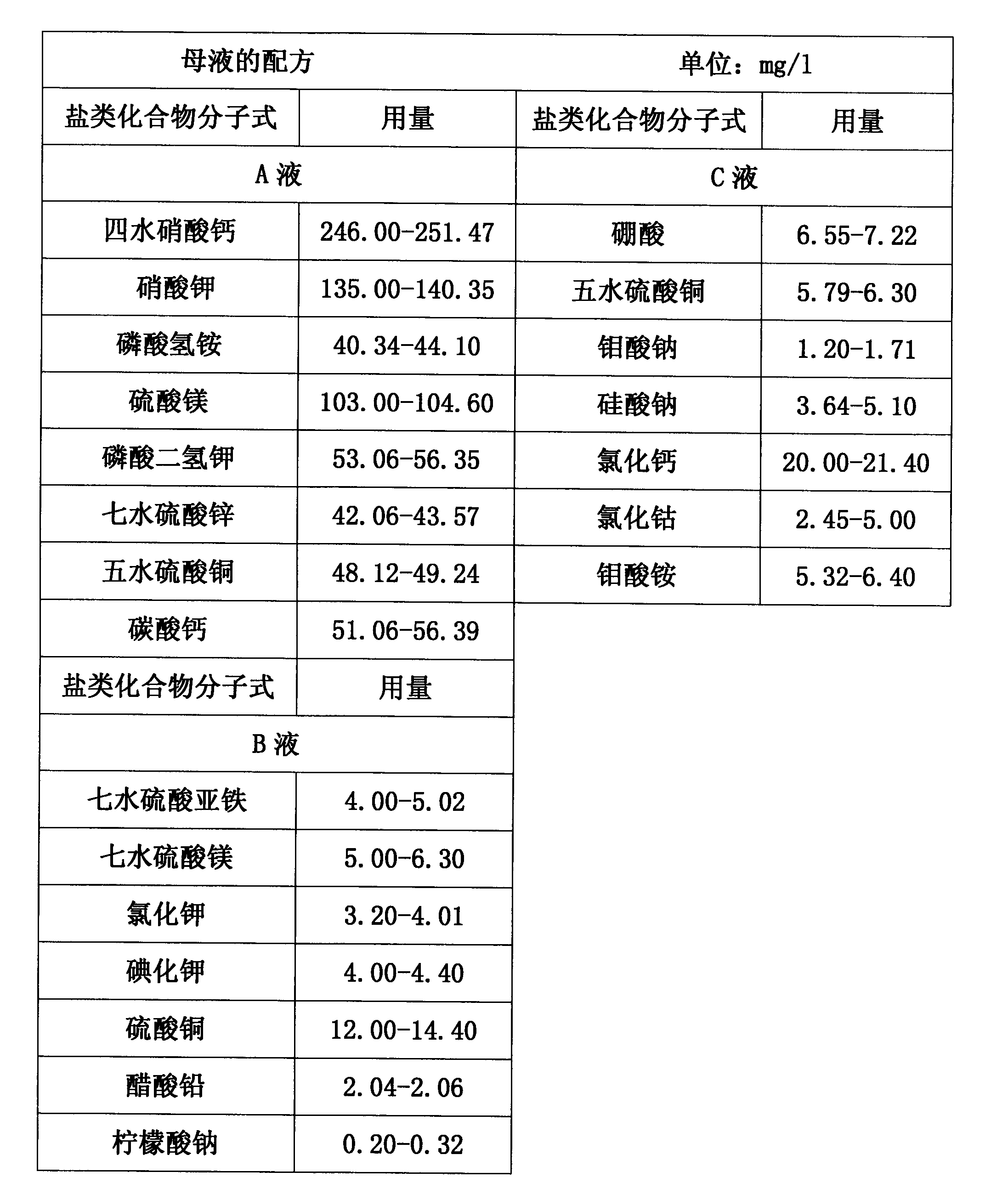Aloe water culture nutrient solution
A technology of nutrient solution and aloe vera water, applied in fertilizer mixture, fertilization device, application and other directions, can solve problems such as nutrient imbalance, and achieve the effect of reducing root rot, scientific formula and promoting growth.
- Summary
- Abstract
- Description
- Claims
- Application Information
AI Technical Summary
Problems solved by technology
Method used
Image
Examples
Embodiment 1
[0012] The aloe hydroponic nutrient solution of the present invention is divided into A solution, B solution and C solution. The main components of each 1000ml A solution are calcium nitrate tetrahydrate 248.74mg, potassium nitrate 137.68mg, ammonium hydrogen phosphate 42.22mg, magnesium sulfate 103.80mg, phosphoric acid Potassium dihydrogen 54.71mg, zinc sulfate heptahydrate 42.82mg, copper sulfate pentahydrate 48.68mg and calcium carbonate 53.73mg; the main components of each 1000ml B solution are ferrous sulfate heptahydrate 4.51mg, magnesium sulfate heptahydrate 5.65mg, potassium chloride 3.60mg, potassium iodide 4.20mg, copper sulfate 12.20mg, lead acetate 2.05mg and sodium citrate 0.28mg; the main components of each 1000ml C solution are boric acid 6.88mg, copper sulfate pentahydrate 6.05mg, sodium molybdate 1.45mg, sodium silicate 4.37 mg, calcium chloride 20.70mg, cobalt chloride 3.73mg and ammonium molybdate 5.86mg.
Embodiment 2
[0014] The main components of each 1000ml A solution are calcium nitrate tetrahydrate 246.00mg, potassium nitrate 135.00mg, ammonium hydrogen phosphate 40.34mg, magnesium sulfate 103.00mg, potassium dihydrogen phosphate 53.06mg, zinc sulfate heptahydrate 42.06mg, copper sulfate pentahydrate 48.12mg And calcium carbonate 51.06mg; the main components of each 1000ml B solution are ferrous sulfate heptahydrate 4.00mg, magnesium sulfate heptahydrate 5.00mg, potassium chloride 3.20mg, potassium iodide 4.00mg, copper sulfate 12.00mg, lead acetate 2.04mg and sodium citrate 0.20mg; The main components of each 1000ml C solution are boric acid 6.55mg, copper sulfate pentahydrate 5.79mg, sodium molybdate 1.20mg, sodium silicate 3.64mg, calcium chloride 20.00mg, cobalt chloride 2.45mg and ammonium molybdate 5.32mg .
Embodiment 3
[0016] The main components of each 1000ml A solution are calcium nitrate tetrahydrate 251.47mg, potassium nitrate 140.35mg, ammonium hydrogen phosphate 44.10mg, magnesium sulfate 104.60mg, potassium dihydrogen phosphate 56.35mg, zinc sulfate heptahydrate 43.57mg, copper sulfate pentahydrate 49.24mg And calcium carbonate 56.39mg; the main components of each 1000ml B solution are ferrous sulfate heptahydrate 5.02mg, magnesium sulfate heptahydrate 6.30mg, potassium chloride 4.01mg, potassium iodide 4.40mg, copper sulfate 14.40mg, lead acetate 2.06mg and sodium citrate 0.32mg; The main components of each 1000ml C solution are boric acid 7.22mg, copper sulfate pentahydrate 6.30mg, sodium molybdate 1.71mg, sodium silicate 5.10mg, calcium chloride 21.40mg, cobalt chloride 5.00mg and ammonium molybdate 6.40mg .
[0017] The experimental group (Example 1, Example 2, Example 3) selected aloe plants of the same size and shape, placed them in the same and suitable environment for one month, ...
PUM
 Login to View More
Login to View More Abstract
Description
Claims
Application Information
 Login to View More
Login to View More - R&D
- Intellectual Property
- Life Sciences
- Materials
- Tech Scout
- Unparalleled Data Quality
- Higher Quality Content
- 60% Fewer Hallucinations
Browse by: Latest US Patents, China's latest patents, Technical Efficacy Thesaurus, Application Domain, Technology Topic, Popular Technical Reports.
© 2025 PatSnap. All rights reserved.Legal|Privacy policy|Modern Slavery Act Transparency Statement|Sitemap|About US| Contact US: help@patsnap.com



